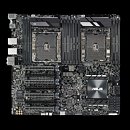Wednesday, October 25th 2017

ASUS Reveals Their WS C621E SAGE Dual Xeon Overclocking Motherboard
Built on Intel's C621 chipset, ASUS's new WS C621E SAGE motherboard possesses some interesting traits. For a start, this workstation motherboard not only supports one LGA-3647 socket processor, but two of them in tandem. That's right. Enterprise users in need of raw processing power can drop in a pair of Intel Xeon Platinum 8180 processors and build themselves a beastly workstation with 56 cores and 112 threads at their disposal. But, what really separates the WS C621E SAGE from the competition is the motherboard's overclocking capability. Since Intel locks the multiplier for their Xeon processors, owners are accustomed to settle for factory clock speeds. However, ASUS has engineered a method to allow Xeon owners to overclock their processors to take their performance to a next level. Given the locked multiplier, we assume that overclocking is probably done through base clock adjustments.
Processing power is crucial for productivity, but having enough memory for heavy-duty tasks is equally important. For that same reason, ASUS has incorporated 12 DDR4 memory slots into the WS C621E SAGE. Users can go with either RDIMM or LR-DIMM ECC modules with speeds up to DDR4-2666. This opens the door to running 1.5 TB of memory. Now that's something you don't see everyday.The motherboard comes with seven PCIe slots, which makes it a great option for professionals who require major graphics power. There is support for 4-Way NVIDIA GeForce SLI, AMD CrossFireX, and 2-Way NVIDIA Quadro SLI configurations. The WS C621E SAGE isn't a slacker in the storage department either. The eight standard SATA III ports from the Intel C621 Chipset brings support for RAID 0, 1, 5, 10 arrays. On the other hand, the ASMedia controller provides two additional SATA III ports for normal storage and four U.2 connectors plus a M.2 socket for hi-speed storage devices. There's even a hidden microSD card reader below the middle memory bank.
The two Intel I210-AT Gigabit LAN controllers provide wired networking, while the Realtek S1220A 7.1-Channel HD Audio codec is responsible for audio duties. Despite the WS C621E SAGE being a workstation motherboard, it has some of the audio features from ASUS's mainstream motherboards like the use of premium Japanese audio capacitors, the unique de-pop circuit, support for DTS Connect, and DTS Headphone:X. The five audio connectors and the optical S/PDIF port are present for connecting different audio devices. Connectivity comes in form of an old-school PS/2 keyboard/mouse combo port, two USB 3.1 Gen 2 ports, four USB 3.1 Gen 1 ports, and four USB 2.0. An USB BIOS Flashback button is also present on the rear I/O panel.
Source:
ASUS
Processing power is crucial for productivity, but having enough memory for heavy-duty tasks is equally important. For that same reason, ASUS has incorporated 12 DDR4 memory slots into the WS C621E SAGE. Users can go with either RDIMM or LR-DIMM ECC modules with speeds up to DDR4-2666. This opens the door to running 1.5 TB of memory. Now that's something you don't see everyday.The motherboard comes with seven PCIe slots, which makes it a great option for professionals who require major graphics power. There is support for 4-Way NVIDIA GeForce SLI, AMD CrossFireX, and 2-Way NVIDIA Quadro SLI configurations. The WS C621E SAGE isn't a slacker in the storage department either. The eight standard SATA III ports from the Intel C621 Chipset brings support for RAID 0, 1, 5, 10 arrays. On the other hand, the ASMedia controller provides two additional SATA III ports for normal storage and four U.2 connectors plus a M.2 socket for hi-speed storage devices. There's even a hidden microSD card reader below the middle memory bank.
The two Intel I210-AT Gigabit LAN controllers provide wired networking, while the Realtek S1220A 7.1-Channel HD Audio codec is responsible for audio duties. Despite the WS C621E SAGE being a workstation motherboard, it has some of the audio features from ASUS's mainstream motherboards like the use of premium Japanese audio capacitors, the unique de-pop circuit, support for DTS Connect, and DTS Headphone:X. The five audio connectors and the optical S/PDIF port are present for connecting different audio devices. Connectivity comes in form of an old-school PS/2 keyboard/mouse combo port, two USB 3.1 Gen 2 ports, four USB 3.1 Gen 1 ports, and four USB 2.0. An USB BIOS Flashback button is also present on the rear I/O panel.




21 Comments on ASUS Reveals Their WS C621E SAGE Dual Xeon Overclocking Motherboard
I dont think TPU reviews server stuff for the most part. Anandtech will review those soon enough. ;)